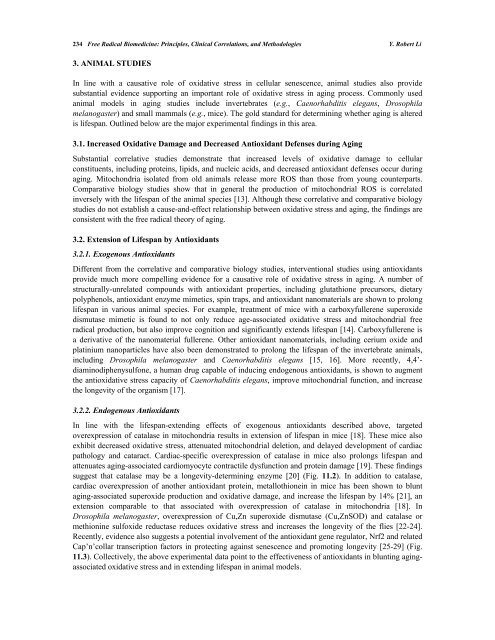Free Radical Biomedicine: Principles, Clinical ... - Bentham Science
Free Radical Biomedicine: Principles, Clinical ... - Bentham Science
Free Radical Biomedicine: Principles, Clinical ... - Bentham Science
Create successful ePaper yourself
Turn your PDF publications into a flip-book with our unique Google optimized e-Paper software.
234 <strong>Free</strong> <strong>Radical</strong> <strong>Biomedicine</strong>: <strong>Principles</strong>, <strong>Clinical</strong> Correlations, and Methodologies Y. Robert Li<br />
3. ANIMAL STUDIES<br />
In line with a causative role of oxidative stress in cellular senescence, animal studies also provide<br />
substantial evidence supporting an important role of oxidative stress in aging process. Commonly used<br />
animal models in aging studies include invertebrates (e.g., Caenorhabditis elegans, Drosophila<br />
melanogaster) and small mammals (e.g., mice). The gold standard for determining whether aging is altered<br />
is lifespan. Outlined below are the major experimental findings in this area.<br />
3.1. Increased Oxidative Damage and Decreased Antioxidant Defenses during Aging<br />
Substantial correlative studies demonstrate that increased levels of oxidative damage to cellular<br />
constituents, including proteins, lipids, and nucleic acids, and decreased antioxidant defenses occur during<br />
aging. Mitochondria isolated from old animals release more ROS than those from young counterparts.<br />
Comparative biology studies show that in general the production of mitochondrial ROS is correlated<br />
inversely with the lifespan of the animal species [13]. Although these correlative and comparative biology<br />
studies do not establish a cause-and-effect relationship between oxidative stress and aging, the findings are<br />
consistent with the free radical theory of aging.<br />
3.2. Extension of Lifespan by Antioxidants<br />
3.2.1. Exogenous Antioxidants<br />
Different from the correlative and comparative biology studies, interventional studies using antioxidants<br />
provide much more compelling evidence for a causative role of oxidative stress in aging. A number of<br />
structurally-unrelated compounds with antioxidant properties, including glutathione precursors, dietary<br />
polyphenols, antioxidant enzyme mimetics, spin traps, and antioxidant nanomaterials are shown to prolong<br />
lifespan in various animal species. For example, treatment of mice with a carboxyfullerene superoxide<br />
dismutase mimetic is found to not only reduce age-associated oxidative stress and mitochondrial free<br />
radical production, but also improve cognition and significantly extends lifespan [14]. Carboxyfullerene is<br />
a derivative of the nanomaterial fullerene. Other antioxidant nanomaterials, including cerium oxide and<br />
platinium nanoparticles have also been demonstrated to prolong the lifespan of the invertebrate animals,<br />
including Drosophila melanogaster and Caenorhabditis elegans [15, 16]. More recently, 4,4’diaminodiphenysulfone,<br />
a human drug capable of inducing endogenous antioxidants, is shown to augment<br />
the antioxidative stress capacity of Caenorhabditis elegans, improve mitochondrial function, and increase<br />
the longevity of the organism [17].<br />
3.2.2. Endogenous Antioxidants<br />
In line with the lifespan-extending effects of exogenous antioxidants described above, targeted<br />
overexpression of catalase in mitochondria results in extension of lifespan in mice [18]. These mice also<br />
exhibit decreased oxidative stress, attenuated mitochondrial deletion, and delayed development of cardiac<br />
pathology and cataract. Cardiac-specific overexpression of catalase in mice also prolongs lifespan and<br />
attenuates aging-associated cardiomyocyte contractile dysfunction and protein damage [19]. These findings<br />
suggest that catalase may be a longevity-determining enzyme [20] (Fig. 11.2). In addition to catalase,<br />
cardiac overexpression of another antioxidant protein, metallothionein in mice has been shown to blunt<br />
aging-associated superoxide production and oxidative damage, and increase the lifespan by 14% [21], an<br />
extension comparable to that associated with overexpression of catalase in mitochondria [18]. In<br />
Drosophila melanogaster, overexpression of Cu,Zn superoxide dismutase (Cu,ZnSOD) and catalase or<br />
methionine sulfoxide reductase reduces oxidative stress and increases the longevity of the flies [22-24].<br />
Recently, evidence also suggests a potential involvement of the antioxidant gene regulator, Nrf2 and related<br />
Cap’n’collar transcription factors in protecting against senescence and promoting longevity [25-29] (Fig.<br />
11.3). Collectively, the above experimental data point to the effectiveness of antioxidants in blunting agingassociated<br />
oxidative stress and in extending lifespan in animal models.

















